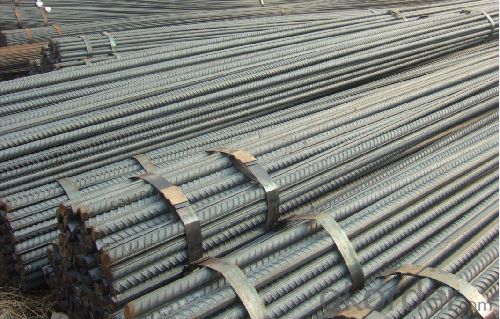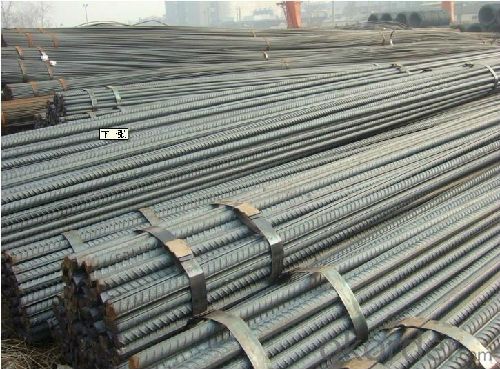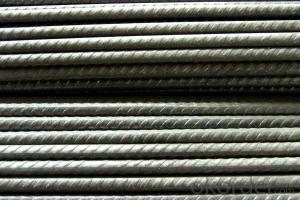Hot Rolled Deformed Bar ou Reinforcement Bar ASTM A615 6mm-50mm
- Loading Port:
- Tianjin
- Payment Terms:
- TT or LC
- Min Order Qty:
- 25 m.t.
- Supply Capability:
- 100000 m.t./month
OKorder Service Pledge
OKorder Financial Service
You Might Also Like
Product Description:
OKorder is offering high quality Hot Rolled Steel I-Beams at great prices with worldwide shipping. Our supplier is a world-class manufacturer of steel, with our products utilized the world over. OKorder annually supplies products to European, North American and Asian markets. We provide quotations within 24 hours of receiving an inquiry and guarantee competitive prices.
Product Applications:
Deformed bar is widely used in buildings, bridges, roads and other engineering construction. Big to highways, railways, bridges, culverts, tunnels, public facilities such as flood control, dam, small to housing construction, beam, column, wall and the foundation of the plate, deformed bar is an integral structure material. With the development of world economy and the vigorous development of infrastructure construction, real estate, the demand for deformed bar will be larger and larger
Product Advantages:
OKorder's Steel I-Beams are durable, strong, and resist corrosion, exact size, regular package, chemical and mechanical properties are stable.
Main Product Features:
· Premium quality
· Prompt delivery & seaworthy packing (30 days after receiving deposit)
· Corrosion resistance
· Can be recycled and reused
· Mill test certification
· Professional Service
· Competitive pricing
Product Specifications:
Manufacture: Hot rolled
Grade: BS4449
Certificates: ISO, SGS, BV, CIQ
Diameter: 6mm,8mm,10mm,12mm,14mm,16mm,18mm,20mm,
22mm,25mm,28mm,32mm,36mm,40mm,50mm
Length: 6M, 9M,12M or as required
Packaging: Export packing, nude packing, bundled
Chemical Composition: (Please kindly find our chemistry of our material based on HRB500 as below for your information)
Grade | Technical data of the original chemical composition (%) | ||||||
C | Mn | Si | S | P | V | ||
HRB400 | ≤0.25 | ≤1.60 | ≤0.80 | ≤0.045 | ≤0.045 | 0.04-0.12 | |
Physical capability | |||||||
Yield Strength (N/cm²) | Tensile Strength (N/cm²) | Elongation (%) | |||||
≥400 | ≥570 | ≥14 | |||||
Theoretical weight and section area of each diameter as below for your information:
Diameter(mm) | Section area (mm²) | Mass(kg/m) | Weight of 12m bar(kg) |
6 | 28.27 | 0.222 | 2.664 |
8 | 50.27 | 0.395 | 4.74 |
10 | 78.54 | 0.617 | 7.404 |
12 | 113.1 | 0.888 | 10.656 |
14 | 153.9 | 1.21 | 14.52 |
16 | 201.1 | 1.58 | 18.96 |
18 | 254.5 | 2.00 | 24 |
20 | 314.2 | 2.47 | 29.64 |
22 | 380.1 | 2.98 | 35.76 |
25 | 490.9 | 3.85 | 46.2 |
28 | 615.8 | 4.83 | 57.96 |
32 | 804.2 | 6.31 | 75.72 |
36 | 1018 | 7.99 | 98.88 |
40 | 1257 | 9.87 | 118.44 |
50 | 1964 | 15.42 | 185.04 |
FAQ:
Q1: Why buy Materials & Equipment from OKorder.com?
A1: All products offered byOKorder.com are carefully selected from China's most reliable manufacturing enterprises. Through its ISO certifications, OKorder.com adheres to the highest standards and a commitment to supply chain safety and customer satisfaction.
Q2: What makes stainless steel stainless?
A2: Stainless steel must contain at least 10.5 % chromium. It is this element that reacts with the oxygen in the air to form a complex chrome-oxide surface layer that is invisible but strong enough to prevent further oxygen from "staining" (rusting) the surface. Higher levels of chromium and the addition of other alloying elements such as nickel and molybdenum enhance this surface layer and improve the corrosion resistance of the stainless material.
Q3: Can stainless steel rust?
A3: Stainless does not "rust" as you think of regular steel rusting with a red oxide on the surface that flakes off. If you see red rust it is probably due to some iron particles that have contaminated the surface of the stainless steel and it is these iron particles that are rusting. Look at the source of the rusting and see if you can remove it from the surface.


- Q:Can steel rebars be used in wastewater storage tanks?
- Indeed, wastewater storage tanks can utilize steel rebars. These rebars are frequently employed as reinforcement in concrete structures, including wastewater storage tanks. By imparting tensile strength to the concrete, the rebars enhance its resistance to cracking and bolster the overall structural integrity of the tank. Moreover, steel rebars possess corrosion-resistant properties, a crucial attribute given the inevitable exposure to corrosive elements in wastewater storage tanks. Consequently, the utilization of steel rebars in these tanks is a prevalent and efficacious practice within the construction industry.
- Q:Are steel rebars suitable for use in aggressive environments?
- Indeed suitable for use in aggressive environments are steel rebars. Commonly utilized in construction projects, particularly in reinforced concrete structures, steel rebars possess high tensile strength and durability. However, when exposed to corrosive elements like moisture, chloride ions, and chemicals, corrosion may occur, leading to weakened rebars and compromised structural integrity of the concrete. To counteract this issue, protective materials such as epoxy or zinc are often applied to steel rebars, creating a barrier against corrosion. Moreover, stainless steel rebars, with their superior corrosion resistance properties, are also employed in aggressive environments. In conclusion, although steel rebars generally prove suitable for aggressive environments, it is essential to consider specific conditions and implement appropriate protective measures to prevent corrosion and uphold the longevity of the reinforced concrete structure.
- Q:How are steel rebars used in the construction of dams?
- Steel rebars are used in the construction of dams to reinforce the concrete structure and provide additional strength and durability. They are typically placed within the concrete to resist tensile forces and prevent cracking or collapsing under the immense pressure of water. The rebars help to distribute the load evenly across the dam, increasing its overall stability and ensuring its long-term structural integrity.
- Q:Can steel rebars be used in historical building preservation?
- Yes, steel rebars can be used in historical building preservation. Steel rebars provide additional strength and stability to the structure, which is essential for preserving and maintaining historical buildings. However, the use of steel rebars should be done carefully and in consultation with architectural and preservation experts to ensure that it does not compromise the historical integrity and aesthetic value of the building.
- Q:How do steel rebars impact the overall cost of a construction project?
- Steel rebars can have a significant impact on the overall cost of a construction project. Firstly, the cost of steel rebars themselves can be quite substantial, especially if large quantities are required. The prices of steel rebars are influenced by factors such as market demand, availability, and fluctuations in raw material prices. Moreover, the installation of steel rebars involves additional expenses such as labor, tools, and equipment. Skilled workers are needed to accurately place the rebars according to the construction plans, and this can increase the cost of labor. Additionally, specialized tools and equipment are required to cut, bend, and tie the rebars, adding to the project's expenses. The use of steel rebars also affects the construction timeline and subsequently impacts the project's cost. Construction projects often have strict deadlines, and any delay in the delivery or installation of rebars can result in additional expenses due to extended labor costs, idle equipment, and potential penalties for delayed completion. Furthermore, steel rebars play a crucial role in providing structural strength and durability to the building. By reinforcing concrete structures, steel rebars enhance their load-bearing capacity and resistance to various forces such as earthquakes and extreme weather conditions. This can reduce the risk of structural failures and the need for costly repairs or replacements in the future. In summary, steel rebars can significantly affect the overall cost of a construction project due to their initial purchase cost, installation expenses, impact on the construction timeline, and the long-term benefits they provide in terms of structural integrity and durability. Proper planning, procurement, and installation of steel rebars are essential to manage costs effectively and ensure the successful completion of the project within the allocated budget.
- Q:What are the guidelines for proper bending of steel rebars on construction sites?
- The guidelines for proper bending of steel rebars on construction sites are essential to ensure structural integrity and safety of the building. Here are some key guidelines to follow: 1. Use the right tools: Utilize a proper rebar bending machine or manual rebar bender specifically designed for steel rebars. These tools ensure precise bending without causing damage or weak spots on the rebar. 2. Determine the required bend angle: Measure and mark the required bend angle on the rebar accurately before bending. Use a protractor or a bending template to achieve the desired angle. 3. Follow the bending radius: The bending radius refers to the minimum radius that the rebar can be bent without causing any damage. Always adhere to the recommended bending radius provided by the manufacturer or structural engineer to avoid fractures or deformations. 4. Secure the rebar firmly: Prior to bending, securely fasten the rebar in the bender to prevent slipping or movement during the bending process. This ensures precise bending and reduces the risk of accidents. 5. Gradual bending process: When bending the rebar, apply gradual pressure and avoid sudden or excessive force. Gradual bending minimizes the risk of cracks or fractures and maintains the rebar's structural integrity. 6. Inspect the bend: After bending, carefully inspect the rebar to ensure it matches the desired angle and there are no visible defects or stress marks. Any faulty bends should be rectified immediately. 7. Proper storage: Store the bent rebar in a designated area, preferably on a flat surface, to prevent distortion or damage. Avoid placing heavy objects on top of the bent rebar to maintain its shape and strength. 8. Follow safety precautions: Always wear appropriate personal protective equipment (PPE), such as gloves and safety glasses, during bending operations. Ensure the work area is clear of obstacles and other workers to avoid accidents. 9. Maintain documentation: Document the bending process, including the angle, radius, and any deviations or issues encountered. This information can be useful for quality control purposes and future reference. 10. Compliance with building codes: Ensure that the bending process complies with local building codes and regulations. Seek guidance from a structural engineer or relevant authorities if necessary. By following these guidelines, construction professionals can ensure the proper bending of steel rebars, resulting in a structurally sound and safe building.
- Q:What is the impact of steel rebars on the carbon footprint of a structure?
- The use of steel rebars in a structure has a significant impact on its carbon footprint. Steel production is a highly carbon-intensive process, resulting in significant greenhouse gas emissions. The extraction of raw materials, manufacturing, transportation, and construction of steel rebars contribute to the overall carbon footprint of a structure. However, steel rebars offer durability, strength, and structural integrity, which can prolong the lifespan of a building and reduce the need for frequent repairs or replacements. Therefore, while steel rebars contribute to the carbon footprint, their use can also result in long-term environmental benefits by reducing the overall material consumption and waste associated with a structure.
- Q:Can steel rebars be painted or coated for aesthetic purposes?
- Yes, steel rebars can be painted or coated for aesthetic purposes. Painting or coating steel rebars can help improve their appearance and blend them with the surrounding structures or environment. The paint or coating can be chosen to match the desired color or style, allowing the rebars to be seamlessly integrated into the overall design. Additionally, painting or coating the rebars can also provide a layer of protection against corrosion and extend their lifespan. However, it is important to note that the paint or coating used should be specifically designed for steel and capable of adhering well to the surface, ensuring durability and longevity.
- Q:Can steel rebars be used in solar power plant construction?
- Yes, steel rebars can be used in solar power plant construction. Steel rebars are commonly used as reinforcement in concrete structures, including the foundations and structural components of solar power plants. They provide strength, durability, and stability to the construction, ensuring the long-term performance and safety of the solar power plant.
- Q:Can steel rebars be used in structures with limited construction space?
- Yes, steel rebars can be used in structures with limited construction space. Steel rebars are versatile and can be easily maneuvered and placed in confined spaces. They are commonly used in construction projects with limited space, such as high-rise buildings, underground structures, and bridges. Their flexibility and strength make them a suitable choice for reinforcing concrete structures in tight construction areas.
1. Manufacturer Overview |
|
|---|---|
| Location | |
| Year Established | |
| Annual Output Value | |
| Main Markets | |
| Company Certifications | |
2. Manufacturer Certificates |
|
|---|---|
| a) Certification Name | |
| Range | |
| Reference | |
| Validity Period | |
3. Manufacturer Capability |
|
|---|---|
| a)Trade Capacity | |
| Nearest Port | |
| Export Percentage | |
| No.of Employees in Trade Department | |
| Language Spoken: | |
| b)Factory Information | |
| Factory Size: | |
| No. of Production Lines | |
| Contract Manufacturing | |
| Product Price Range | |
Send your message to us
Hot Rolled Deformed Bar ou Reinforcement Bar ASTM A615 6mm-50mm
- Loading Port:
- Tianjin
- Payment Terms:
- TT or LC
- Min Order Qty:
- 25 m.t.
- Supply Capability:
- 100000 m.t./month
OKorder Service Pledge
OKorder Financial Service
Similar products
New products
Hot products
Related keywords





























